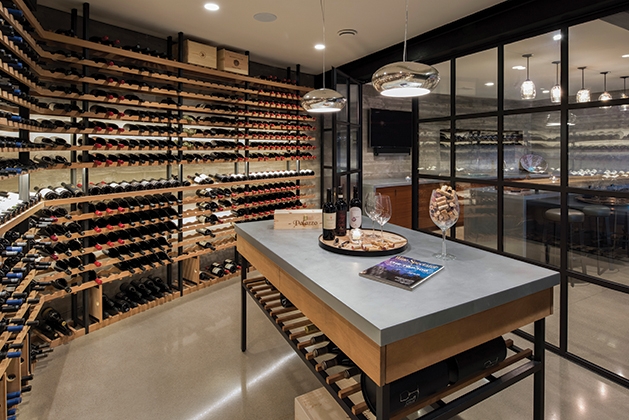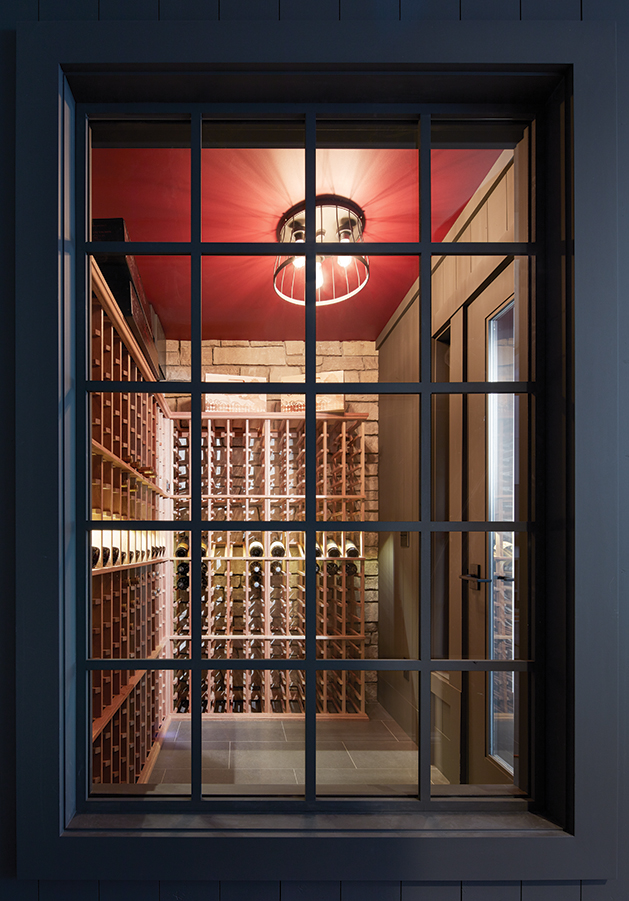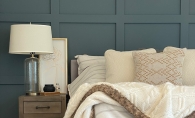
Hearing “wine cellar” might conjure old movie images of a candlelit trip down dark, musty stairs to a crumbling stone cave. That was then; this is now. Hagstrom Builder has been building custom homes since 1962, and it’s seeing a fresh, new trend in wine cellars. The biggest change is these rooms are moving up in the world—literally—from the basement to the main floor. Displaying a collection of spirits has become a form of art, and Peter, Erik and Nils Hagstrom are getting creative to elevate their clients’ collections to show-stopping levels of artistry.
The old cave-style wine cellar is better for storing wine, but that doesn’t work for those who want to have their wares visible from the main floor entertainment area, or if the goal is to have one’s expansive (and expensive!) collection be the first thing visitors see when entering a home.
Peter Hagstrom, president of Hagstrom Builder, says the wine cellars that the company puts in homes range anywhere from $15,000 to $200,000, and wine collection has become like car or art collections. It’s another form of personal expression when clients builds their dream homes.
To help this premier home builder catch the vision for their vino, clients share Pinterest posts and pictures from restaurants, houzz.com and homes of friends. Usually, a wine cellar is an afterthought, and it’s tricky to incorporate it into an existing home’s structure. With some high-end building projects, they are able to make the wine cellars the architects’ first considerations, not the last.

Nils Hagstrom, project manager, says the biggest challenge in building a custom wine cellar lies in the coordination of a variety of industries as they move into the actual build. “All the different trades have to come together for this. The quality of the craftsmanship is of utmost importance, so there’s close collaboration between steel fabricator, millwork, HVAC and electrical,” he says.
To jump start the coordination for a client project in Pine Tree Lake near Dellwood, wine cellar consultant Jeff Hagen was brought into the process. “The core goal is how to maintain the necessary temperature in a way that doesn’t negatively affect the rest of the house,” Hagen says. Hagstrom Builder has found that exploring nuances with Hagen before starting cellar designs helps ensure the end product fits the owner’s needs and desires. (Hagen is the only professional wine cellar consultant within a 1,000 mile radius of the Twin Cities.)
Hagen first asks clients, “What do you collect?” His next questions, “How often do you turn over your wine inventory? Are you keeping bottles for 30 years or drinking within five?” Answers determine whether or not a cooling system, room insulation and vapor barriers are needed, which can triple the cost of a cellar. He says wine is safe in the ambient temperature of a typical Minnesota basement if the wine will be turned over within a few years. (Not so in Florida!) Then he needs to determine the make up of the client’s collection—normal 750ml bottles, splits (which are half the size), magnums (that are twice the size of average bottles) and beyond.
Once the nature of the collection is known, then custom racks can be designed. For example, a pinot noir bottle has low shoulders and is fatter than a Bordeaux bottle—the original standard shape and size for wine bottles—so a rack needs to accommodate specific inventory bottle widths. Then bottle thickness and weight comes into play. The Champagne bottle has significantly thicker glass, so it needs slightly more structural support. Hagen also asks clients general questions about collection versus consumption. In the Pine Tree Lake home,
a separate cellar was created for Champagne and other wines that are best served chilled to have on hand for immediate use, and the larger section of the cellar is for long-term storage in 55 degrees.
To make the lighting a design statement in the Pine Tree Lake home, grooves were cut into the underside of wood bottle racks for LED strip lights. The metal framework, necessary to support the weight of the wine, was custom built, as well, to give the cellar a unique, custom look. The final touch was the zinc-topped table, a nod to classic bar tops in Paris, centered under a stunning light fixture—all for opening and tasting
on the spot.









